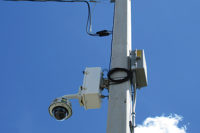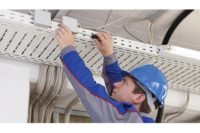There was a time when power and transmission were delivered by distinct solutions, but power over Ethernet (PoE) solutions have changed that dynamic considerably by delivering power and video surveillance signals over a single cable. Today, most manufacturers’ offerings include PoE-powered solutions for the simple reason that it’s far easier to install and for the most part eliminates the need for local power where edge devices are installed.
“Installing power for a modern networked video surveillance system is easier than ever,” says Ronnie Pennington, sales engineer, Altronix, Brooklyn, N.Y. “In the past, electricians had to provide power locally at every camera or network appliance — an expensive and time-consuming process. Today, new power options are available for Ethernet cable, coaxial cable, and fiber composite cabling. Because each of these can now carry both power and data simultaneously, a single cable run to each device is all that is needed, saving time and installation costs.”
A primary challenge with these solutions is the ever-increasing requirement for more power. The original PoE standard offers 15 watts, and PoE+ offers 30 watts. In September 2018, a new standard, universal power over Ethernet (UPoE, also known as 4PPoE) was introduced to provide two new power types: type 3 (up to 55 watts) and type 4 (up to 90 to 100 watts), as well as support for high-bandwidth 2.5 gigabits per second (Gbps), 5 Gbps and 10 Gbps.
“These additional new PoE capabilities expand the types of applications that are candidates to be PoE-powered, such as high-performance wireless access points and surveillance cameras,” says Skip Haight, vice president of marketing, Communication Networks (ComNet), Danbury, Conn.
When using PoE switches, it’s important to remember that while they offer an overall maximum wattage for all the ports of the switch, they may not offer enough power to support all those ports at their maximum wattage.
“The PoE switch may have 16 ports but the maximum wattage may only support less than 16 ports at the ports’ full wattage level,” says Jennifer Kerr, project manager, SecurityTronix, West Chester, Pa.
In general, when planning how a system will be powered and how video will be transmitted from point A to point B, there are five key factors that will determine its ultimate success.
1 Maintaining the Signal
Given the critical nature of security, signal interruption or degradation is simply unacceptable and can have dire consequences. However, this is one of the most common challenges with video surveillance systems, and can be complicated by the number of devices in a system.
“Video systems can be relatively simple or quite complex, comprised of cameras and devices for transmission, encoding and decoding, signal conditioning, monitoring, control, multiplexing and recording. Even a well-designed video system can experience failure,” Haight describes.
One potential issue security integrators may not consider can be seen with using IR cameras. When these cameras are installed during the day, the image appears fine, Kerr says. However, when evening comes and the lights go down, on come the IR LEDs, which require greater power in order to see in total darkness.
“If improper power was used signal degradation will occur,” she explains. “Integrators can overcome a loss of video at night when IRs come on by calculating overall power draw with IRs on or by calling us 24/7/365 [and asking a] support team member to assist in the proper powering of devices for their specific project needs.”
8 Reasons Behind Signal Degradation & How to Prevent it
As with any electronic communications system, almost all the causes of video signal degradation can be grouped into the following eight general categories, according to Skip Haight of ComNet:
- User error. A well-designed system along with well-written user instructions and good training can minimize user error.
- Intentional or malicious actions. Tamper switches and enclosures or areas with access control and secondary monitoring systems may need to be considered depending on the level of concern.
- Equipment failure. Selecting high-quality, well-designed products is the best defense against premature component failure. Proper system design can help minimize losses from environmental influences.
- Cabling issues. All cabling should be strictly specified as to pin-out, composition, number of strands or conductors, shielding or lack of a metallic shield, maximum allowable lengths, etc.
- Power and grounding issues. If the proper amount of voltage is not available for a device, it will respond by altering the amount of current that it will draw in an attempt to maintain constant power consumption. It goes without saying that providing too much voltage to a device will damage it. Similarly, providing too little voltage can damage an electronic device, as well.
- Electromagnetic interference (EMI). Sources of EMI may be difficult to control, especially if it is in a location not directly controlled or owned by the video system user. Physical separation, shielding, and use of ferrite rings in power and signal cabling are the best defenses from EMI.
- Compatibility issues. When mixing devices from different sources that must communicate with each other, proper selection and integration of components warrants attention to detail. In addition to making sure that signal types, levels, and impedances match, compliance with standards must be considered.
- Improper system design. Failures, errors or omissions during system design can have consequences that range from mild inconvenience to system failure and economic losses. Most issues have been covered in the previously listed points, but should be addressed during system design.
2 Extending Power Over Longer Distances
Regardless of the type of power used, distance limitations will exist. When a camera requires power over a distance that exceeds the maximum standard capability of a powering device, it requires either running a long cable for PoE or using two conductors for DC power. To ensure the success of these approaches, there are solutions available to increase that distance and reduce the chance of voltage drops.
“For IP PoE cameras, using an extended PoE will increase the distance from 328 feet to up to 820 feet,” Kerr says. “A normal 12VDC power supply will provide power up to 250 to 300 feet, depending on the type of conductor used. To overcome this in a long run, there are power supplies with added DC voltage so the extra voltage drop can be offset. Typical units have ratings, such as 18 VDC, 24 VDC and 36 VDC, and the unit needed can be easily calculated using a voltage drop tool online.”
Pennington says there are three keys to avoiding under-voltage issues. The first is to know the acceptable voltage of the cameras and other devices you plan to use.
“It isn’t enough to know that they are PoE-capable, or 12V — check the specifications to confirm the specific PoE type or allowable input voltage range, paying particular attention to the minimum values,” he says.
It’s also important to calculate expected voltage drop based on planned distances, load current and cable gauges, and to confirm that those expected voltage drops will not cause problems with the devices by confirming the voltage output of your power supplies, subtracting the expected voltage drops, and comparing the result to the minimum required voltage inputs of your devices.
“If discrepancies are detected, fix them now in the plan, rather than later in the field,” Pennington says.
3 Harsh Environments
Powering equipment in harsh environments is a big concern, as extreme heat, cold, humidity, shock and vibration can have a negative effect on power supplies. If the power supply fails, the equipment it is powering stops operating.
If an application requires equipment to operate in these difficult, unconditioned, out-of-plant types of environments, one of the often-overlooked challenges is how to power that equipment. If the installation has AC operating power, this can be a bit easier, Haight says.
“In most instances, with an incoming 120VAC supply of electricity, an AC to DC power supply is used to power the devices,” he says.
However, cameras and network gear can vary in their power requirements. Some operate on 24VAC, others 12-48VDC. For example, PoE devices require 48VDC at different amperages to supply ranges of wattage to power these devices. Adding PTZ, blowers and heaters to the mix only increases power demands.
“When installed in extreme temperature locations, you must de-rate a power supply, so it’s important to compensate for this when selecting a power supply,” Haight says. “For example, at 75 deg. Celsius, a 240-watt supply is only supplying about 120 watts, so if you need 240 watts on a PoE switch that supplies power to your cameras, the requirement to meet the real power needs would be to select at least a power supply that delivers 480 watts.”
4 Surge Protection
When left unprotected from surge energy, utility-supplied video power can leave equipment vulnerable to damage, destruction and downtime, says Rich Mitchell, technical sales director, DITEK, Largo, Fla. The same holds true for the connection wires to externally mounted equipment.
“These copper conductors become the path of surge to your equipment. By installing the appropriate surge solution for each exposed portion of your system, you will increase your system’s up time and reliability,” Mitchell says.
In some cases, the surge protection solution can create interference with the video signal, leading an integrator to choose not to use it, which leaves equipment unprotected and can cause far greater issues than signal interference. Therefore, it is up to the integrator to choose surge protection solutions wisely.
“The surge protector should act as a harmless coupler while in standby mode. When triggered by a surge event, the surge protector will go into conduction and dissipate the overvoltage surge energy to ground,” Mitchell says. “When the fault is removed, the surge protector will release its hold on ground and return to standby mode. The data protectors you choose should act as harmless couplers while in standby mode, and should pass data speeds of up to 10GbE (10 gigabit Ethernet) without signal degradation.”
5 Have a Backup Plan
Video surveillance systems require clean and stable power to operate optimally. Between potentially damaging surge energy and intermittent power glitches that are present on any electrical grid, downtime and data loss can be very real possibilities.
“Power can be unpredictable. With rolling brownouts and Mother Nature power outages, integrators can proactively protect a video surveillance system from failure or interruption by incorporating UPS (universal power supplies) into every install,” Kerr says.
In many ways, a quality UPS can overcome many of the issues associated with powering systems, in addition to providing continuity.
“You should always protect your video surveillance systems’ electrical source of supply from damage with quality power products,” Mitchell says. “Partner this protection with a suitably sized UPS (uninterruptible power supply) to maintain clean power to your critical electronics, and you will have provided the correct surge solution.”
More Online
For more information about video power, visit SDM’s website where you’ll find the following articles.
“Practical Advice for Getting Surveillance Video From Point A to Point B”
www.SDMmag.com/getting-video-from-a-to-b
“6 Key Questions About Video Power & Transmission”







